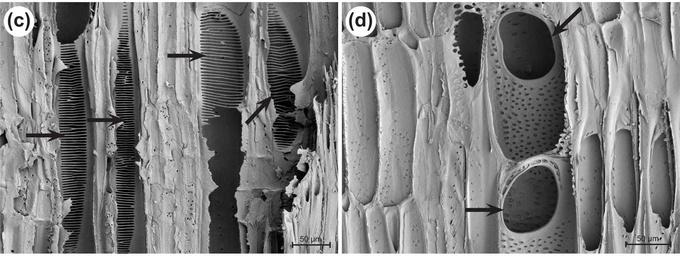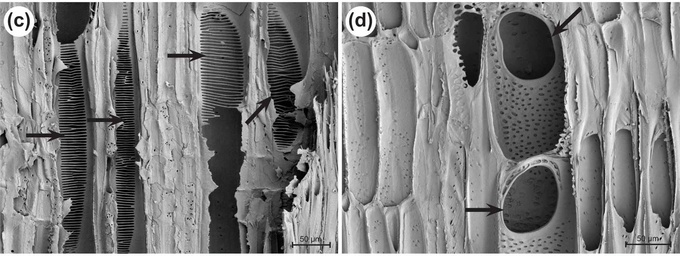
Background and context
Baileyan trends in wood anatomy are arguably one of the most common textbook examples of evolutionary patterns in plant anatomy. This set of linear “primitive-to-specialised” transformation series in wood anatomical features found its origin in a very broad comparison of the size of the water conductive cells in woody land plants [1]. Later, Bailey’s students hypothesised that long and slender gymnosperm tracheids evolved into long and narrow, angiosperm vessel elements with scalariform perforations including many bars (often > 20). These primitive vessel elements further developed into wider and thus hydraulically more efficient water conducting cells with simple perforations [2]. This evolutionary scheme was later confirmed by paleobotanical evidence, showing that scalariform vessel perforations were much more abundant in the Cretaceous than in the Tertiary [3].

Fig. 1 Illustrations of SEM surfaces (c-d) showing the marked difference between the scalariform vessel perforations of Viburnum (c) and the simple vessel perforations of Sambucus (d).
Objectives and goals
Angiosperm wood with simple vessel perforations evolved many times independently from wood with scalariform perforations, but detailed studies to understand why these evolutionary transitions in wood evolution have happened are lacking. The major goal of this MSc thesis is to dig deeper into the paleoclimatic triggers that have driven major evolutionary shifts in the wood of asterids, which is one of the major groups within angiosperms. This MSc thesis follows up on a recent paper where we investigated the climatic drivers behind the striking difference in wood anatomy between two closely related asterid genera, Viburnum and Sambucus. We found that the lack of selective pressure for high conductive efficiency during early diversification of Viburnum and the potentially adaptive value of scalariform perforations in frost-prone cold temperate climates have retained the primitive wood syndrome, while higher temperatures during early diversification of Sambucus have triggered the evolution of simple vessel perforations, allowing a more efficient long distance water transport [4].
Material, tasks and approach
The Viburnum-Sambucus lineage represents only one of the 10 major shifts within asterids. To interpret the vessel perforation trends in a wider framework, we propose a broad-scale molecular dating approach at the flowering plant level, enabling us to use credible fossil calibrations. Using this broad-scale analysis strategy, we can compare the dating estimates of all the 10 independent shifts simultaneously, and link these dates to specific paleoclimatic conditions.
The backbone for this MSc thesis is represented by an available huge aligned dataset using rbcL and matK sequences that are retrieved from GenBank, based on over 30000 angiosperm species and over fifty fossil calibration points [Janssens et al., unpublished]. Due to the large size of the rbcL - matK database, a maximum likelihood (ML) based method (RAxML) will be performed using the Cipres scientific portal (200 independent runs). The phylogenetic relationships of all species in the aligned dataset are constrained at the family level before the RAxML ML analysis. This taxon constraining is necessary because the discriminatory power of matK and rbcL at the genus and species level comes at the cost of correct “deep” phylogenetic reconstruction. Furthermore, constraining until family level reduced computational time for the RAxML method. Molecular dating will be completed using TreePL version 1.0. It is expected that a small number of new sequences needs to be generated and added to the database in order to include all the major shifts.
Requirements
Experience with evolutionary techniques and sequencing is recommended.
References
[1] Bailey IW, Tupper WW. 1918. Size variation in tracheary cells: I. A comparison between the secondary xylems of vascular cryptogams, gymnosperms and angiosperms. Proceedings of the American Academy of Arts and Sciences USA 54: 147-204.
[2] Carlquist S. 1975. Ecological strategies of xylem evolution. Berkeley, USA: University of California Press.
[3] Wheeler EA, Baas P. 1991. A survey of the fossil record for dicotyledonous wood and its significance for evolutionary and ecological wood anatomy. IAWA Journal 312: 275-318.
[4] Lens F, Vos RA, Charrier G, van der Niet T, Merckx V, BaasP, Aguirre Gutierrez J, Jacobs B, Chacon Dória L, Smets E, Delzon S, Janssens SB. 2016. Scalariform-to-simple transition in vessel perforation plates triggered by differences in climate during the evolution of Adoxaceae. Annals of Botany 118: 1043-1056.